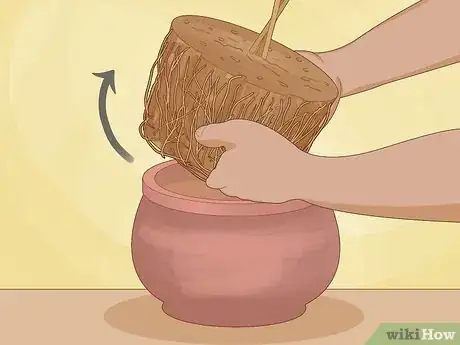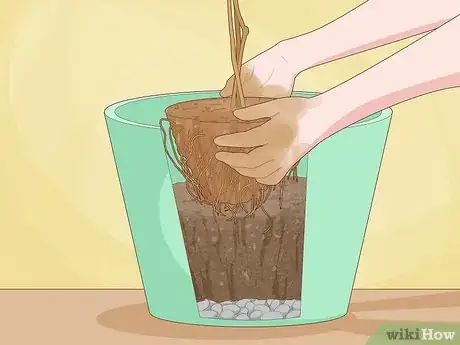This article was co-authored by Lauren Kurtz. Lauren Kurtz is a Naturalist and Horticultural Specialist. Lauren has worked for Aurora, Colorado managing the Water-Wise Garden at Aurora Municipal Center for the Water Conservation Department. She earned a BA in Environmental and Sustainability Studies from Western Michigan University in 2014.
There are 9 references cited in this article, which can be found at the bottom of the page.
wikiHow marks an article as reader-approved once it receives enough positive feedback. This article received 13 testimonials and 96% of readers who voted found it helpful, earning it our reader-approved status.
This article has been viewed 278,804 times.
Ficus trees are a family tropical plants, vines, and shrubs that make adaptable potted plants both indoors and outdoors. To keep your ficus plant healthy, transplanting it to a new pot or planter every few years is recommended. If your ficus tree has outgrown its old pot, prepare a new container for the tree in a suitable climate. Making the transplant as easy as possible on the ficus will help it thrive in its new environment and avoid trauma following repotting.
Steps
Prepping the Pot and Ficus
-
1Repot your ficus tree in springtime, if possible. This is your ficus tree's strongest season—in winter, summer, and fall, your ficus tree may be less adaptable. If you can wait until spring to replant your plant, leave the plant in its current pot until then.
- Most ficus varieties thrive best if you repot them about once a year.
- Indoor ficus trees are generally more adaptable to repotting, even if the season isn’t ideal.
-
2Repot your plant immediately if it has become pot-bound. Pot-bound plants are more prone to developing diseases or becoming starved of nutrients. If you notice any of the following signs, repot your plant as soon as you can:[1]
- Stunted foliage growth
- Roots growing through the drainage holes
- Weak or wilting foliage
Advertisement -
3Remove the ficus carefully from its existing pot. Instead of tugging on the ficus, squeeze both sides of the container and turn it upside down. Tap the bottom of the pot until you loosen the plant and pull it out gently at the base.[2]
- Tugging on the ficus tree can damage or remove its leaves and flowers.
- Have a friend stand near the upside down ficus to catch it if it falls out of the pot.
-
4Choose a pot that is the same size or larger than the root system. Inspect your plant's root system after you pull it out and transplant it to a pot with the same depth. This will give your plant enough room to adapt without constricting the root system. If your plant's root system is too large, you can also cut back up to 20% of the root system.[3]
-
5Put a layer of rocks in the bottom of the pot. Place a 1 in (2.5 cm) layer of small rocks into the new pot. This will aid the pot in water drainage and prevent soggy soil.[6]
- You can buy rocks suitable for plant containers at most garden centers or nurseries.
Transplanting the Ficus
-
1Fill the pot partway with well-draining soil. Your ficus needs well-draining soil, preferably peat mix, to prevent it from becoming waterlogged. Add soil until the pot is about 1/4 to 1/2 of the way full—you will fill it up completely as you transplant the ficus.
- You can buy well-draining soil mixes at most nurseries or garden centers. Check the packaging for "well-draining" or ask an employee for assistance.
- To check soil drainage, dig a 1 foot (0.30 m) hole into the dirt and fill it with water. If the soil drains completely within 5-15 minutes, it is well-draining soil.[7]
- Make sure that the new pot also has a few holes in the bottom to aid drainage.[8]
-
2Loosen the roots before replanting the ficus. Use your hands to loosen the root ball as much as you can without breaking it. This will help the ficus absorb more water and nutrients when you transplant it and adapt better to its new container.[9]
-
3Place your ficus into the pot and fill it with soil. Position the ficus tree upright into the pot. Fill the rest of the pot with soil until you reach the soil level of the plant's original level.
- Don't make your soil level any higher than the original container, which can suffocate the roots.[10]
-
4Place the pot in a spot with mild temperatures and bright lighting. Ficus trees prefer temperatures of around 60–75 °F (16–24 °C), or around room temperature. They also prefer bright, but not direct, sunlight. Whether you place your ficus tree indoors or outdoors, choose a spot with with moderate temperatures and lighting.[11]
- Avoid spots with sudden temperature changes or cold drafts. Near a closed window, for example, is better than by an open door.
Caring for your Repotted Ficus
-
1Water the ficus tree if the soil's top feels dry. Stick your finger into the soil—if the first inch or several centimeters feel dry, water your plant until the soil is moist. Check the soil every day for dryness. How often you need to water the plant may fluctuate based on the temperature, season, and humidity.[12]
- Water your ficus immediately after planting or whenever you notice the top layer of soil drying out.
- During spring or summertime, fill a spray bottle with water and mist the ficus’s leaves daily.[13]
-
2Fertilize your plant 1-2 times a month during the spring and summer. During warmer seasons, spray a fertilizer over your ficus tree once every 2-4 weeks. In colder seasons, cut back to fertilizing the plant once monthly.
- Avoid fertilizing your plant more than once a month in winter when the tree is dormant.
- Diluted liquid fertilizers work best with ficus plants.[14]
-
3Clean your ficus leaves with a soft cloth. If your ficus leaves look dusty, dip a washcloth or sponge in lukewarm water. Gently wipe the surface of the leaves to keep them glossy and lustrous.[15]
- Do not use dish soap or other cleaners to clean your ficus.
-
4
Expert Q&A
Did you know you can get expert answers for this article?
Unlock expert answers by supporting wikiHow
-
QuestionHow can I encourage root growth after transplanting my ficus?
 Lauren KurtzLauren Kurtz is a Naturalist and Horticultural Specialist. Lauren has worked for Aurora, Colorado managing the Water-Wise Garden at Aurora Municipal Center for the Water Conservation Department. She earned a BA in Environmental and Sustainability Studies from Western Michigan University in 2014.
Lauren KurtzLauren Kurtz is a Naturalist and Horticultural Specialist. Lauren has worked for Aurora, Colorado managing the Water-Wise Garden at Aurora Municipal Center for the Water Conservation Department. She earned a BA in Environmental and Sustainability Studies from Western Michigan University in 2014.
Professional Gardener
-
QuestionIs okay to trim my ficus' roots where they have emerged through a hole in the bottom of my pot? This ficus has been in the same pot for 8 years.
 Lauren KurtzLauren Kurtz is a Naturalist and Horticultural Specialist. Lauren has worked for Aurora, Colorado managing the Water-Wise Garden at Aurora Municipal Center for the Water Conservation Department. She earned a BA in Environmental and Sustainability Studies from Western Michigan University in 2014.
Lauren KurtzLauren Kurtz is a Naturalist and Horticultural Specialist. Lauren has worked for Aurora, Colorado managing the Water-Wise Garden at Aurora Municipal Center for the Water Conservation Department. She earned a BA in Environmental and Sustainability Studies from Western Michigan University in 2014.
Professional Gardener It’s time to up-pot your tree. Gently remove a small amount of the roots growing out of the bottom of the pot and transplant them into a larger pot. Do this sooner rather than later to preserve the health of your ficus. Use a pot slightly larger than the root ball. Going forward, repot your ficus once a year or every other year.
It’s time to up-pot your tree. Gently remove a small amount of the roots growing out of the bottom of the pot and transplant them into a larger pot. Do this sooner rather than later to preserve the health of your ficus. Use a pot slightly larger than the root ball. Going forward, repot your ficus once a year or every other year. -
QuestionDo I separate the roots?
 Community AnswerYes, you can tease out the roots, being careful not to damage them. At this time it is a good idea to trim roots that are root bound. Trim the hardened roots not the fibrous roots. This will promote branching of the roots and promote fibrous root growth.
Community AnswerYes, you can tease out the roots, being careful not to damage them. At this time it is a good idea to trim roots that are root bound. Trim the hardened roots not the fibrous roots. This will promote branching of the roots and promote fibrous root growth.
Warnings
- Although not all ficus plants are poisonous, some can cause skin irritation. Check whether your ficus plant is poisonous and, if so, wear gloves while handling it at all times.[19]⧼thumbs_response⧽
Things You'll Need
- Pot
- Well-draining soil
- Rocks
- Water
- Fertilizer
- Soft cloth
- Pruning shears
References
- ↑ https://extension.psu.edu/repotting-houseplants
- ↑ http://www.weekendgardener.net/houseplant-care/how.to.grow.and.care.for.weeping.fig.htm
- ↑ https://www.apartmenttherapy.com/fiddle-leaf-fig-trees-ficus-lyrata-growing-care-199919
- ↑ https://www.houseplant411.com/houseplant/ficus-alii-how-to-grow-care-for-ficus-alii
- ↑ http://www.weekendgardener.net/houseplant-care/how.to.grow.and.care.for.weeping.fig.htm
- ↑ https://www.epicgardening.com/rubber-tree-plant/
- ↑ https://www.treepeople.org/sites/default/files/pdf/resources/How-to%20Test%20Soil%20Drainage.pdf
- ↑ https://www.houseplantsexpert.com/rubber-plant.html
- ↑ http://www.weekendgardener.net/houseplant-care/how.to.grow.and.care.for.weeping.fig.htm
- ↑ http://www.weekendgardener.net/houseplant-care/how.to.grow.and.care.for.weeping.fig.htm
- ↑ https://www.anbg.gov.au/gnp/interns-2015/ficus-coronata.html
- ↑ https://www.apartmenttherapy.com/fiddle-leaf-fig-trees-ficus-lyrata-growing-care-199919
- ↑ https://www.houseplantsexpert.com/rubber-plant.html
- ↑ https://www.houseplantsexpert.com/rubber-plant.html
- ↑ https://www.houseplantsexpert.com/rubber-plant.html
- ↑ https://www.houseplant411.com/houseplant/ficus-alii-how-to-grow-care-for-ficus-alii
- ↑ http://www.missouribotanicalgarden.org/PlantFinder/PlantFinderDetails.aspx?kempercode=b599
- ↑ https://www.epicgardening.com/rubber-tree-plant/
- ↑ https://www.houseplant411.com/houseplant/ficus-alii-how-to-grow-care-for-ficus-alii
About This Article
To keep your ficus tree healthy, transplant it to a new pot or planter every few years. If possible, plan to repot your ficus in the spring, when it’s strongest. Start by getting a pot that's the same size or one size large than the one you've been using. Place a 1-inch layer of small rocks into it to help with water drainage and prevent soggy soil. Then, fill the pot partway with well-draining soil, like a peat mix. Once the new pot is ready, gently pull the plant out of its old pot. Use your hands to loosen the root ball of your ficus to help it absorb more water and nutrients when you place it in the new container. Put your ficus in the pot, fill it with soil, and put it in a spot with mild temperatures and bright lighting. To learn how to care for your repotted ficus, keep reading!







































































